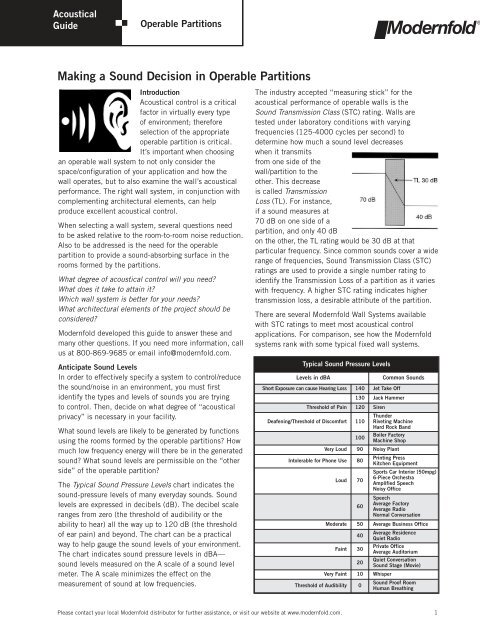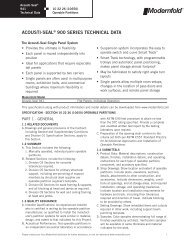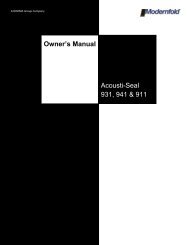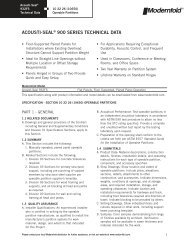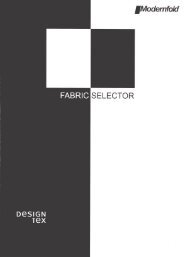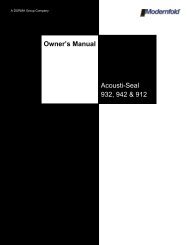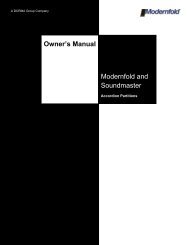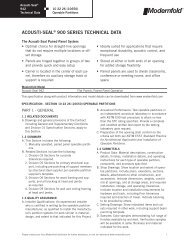Making a Sound Decision in Operable Partitions - Richelieu
Making a Sound Decision in Operable Partitions - Richelieu
Making a Sound Decision in Operable Partitions - Richelieu
Create successful ePaper yourself
Turn your PDF publications into a flip-book with our unique Google optimized e-Paper software.
Acoustical<br />
Guide<br />
<strong>Operable</strong> <strong>Partitions</strong><br />
<strong>Mak<strong>in</strong>g</strong> a <strong>Sound</strong> <strong>Decision</strong> <strong>in</strong> <strong>Operable</strong> <strong>Partitions</strong><br />
Introduction<br />
Acoustical control is a critical<br />
factor <strong>in</strong> virtually every type<br />
of environment; therefore<br />
selec tion of the appropriate<br />
oper able partition is critical.<br />
It’s important when choos<strong>in</strong>g<br />
an operable wall system to not only consider the<br />
space/configuration of your application and how the<br />
wall operates, but to also exam<strong>in</strong>e the wall’s acoustical<br />
performance. The right wall system, <strong>in</strong> conjunction with<br />
complement<strong>in</strong>g architectural elements, can help<br />
produce excellent acoustical control.<br />
When select<strong>in</strong>g a wall system, several questions need<br />
to be asked relative to the room-to-room noise reduction.<br />
Also to be addressed is the need for the operable<br />
partition to provide a sound-absorb<strong>in</strong>g surface <strong>in</strong> the<br />
rooms formed by the partitions.<br />
What degree of acoustical control will you need?<br />
What does it take to atta<strong>in</strong> it?<br />
Which wall system is better for your needs?<br />
What architectural elements of the project should be<br />
considered?<br />
Modernfold developed this guide to answer these and<br />
many other questions. If you need more <strong>in</strong>formation, call<br />
us at 800-869-9685 or email <strong>in</strong>fo@modernfold.com.<br />
Anticipate <strong>Sound</strong> Levels<br />
In order to effectively specify a system to control/reduce<br />
the sound/noise <strong>in</strong> an environment, you must first<br />
identify the types and levels of sounds you are try<strong>in</strong>g<br />
to control. Then, decide on what degree of “acoustical<br />
privacy” is necessary <strong>in</strong> your facility.<br />
What sound levels are likely to be generated by functions<br />
us<strong>in</strong>g the rooms formed by the operable partitions? How<br />
much low frequency energy will there be <strong>in</strong> the generated<br />
sound? What sound levels are permissible on the “other<br />
side” of the operable partition?<br />
The Typical <strong>Sound</strong> Pressure Levels chart <strong>in</strong>dicates the<br />
sound-pressure levels of many everyday sounds. <strong>Sound</strong><br />
levels are expressed <strong>in</strong> decibels (dB). The decibel scale<br />
ranges from zero (the threshold of audibility or the<br />
ability to hear) all the way up to 120 dB (the threshold<br />
of ear pa<strong>in</strong>) and beyond. The chart can be a practical<br />
way to help gauge the sound levels of your environment.<br />
The chart <strong>in</strong>dicates sound pressure levels <strong>in</strong> dBA—<br />
sound levels measured on the A scale of a sound level<br />
meter. The A scale m<strong>in</strong>imizes the effect on the<br />
measurement of sound at low frequencies.<br />
The <strong>in</strong>dustry accepted “measur<strong>in</strong>g stick” for the<br />
acoustical performance of operable walls is the<br />
<strong>Sound</strong> Transmission Class (STC) rat<strong>in</strong>g. Walls are<br />
tested under laboratory conditions with vary<strong>in</strong>g<br />
frequencies (125-4000 cycles per second) to<br />
deter m<strong>in</strong>e how much a sound level decreases<br />
when it transmits<br />
from one side of the<br />
wall/partition to the<br />
other. This decrease<br />
is called Transmission<br />
Loss (TL). For <strong>in</strong>stance,<br />
if a sound measures at<br />
70 dB on one side of a<br />
parti tion, and only 40 dB<br />
on the other, the TL rat<strong>in</strong>g would be 30 dB at that<br />
particular frequency. S<strong>in</strong>ce common sounds cover a wide<br />
range of frequencies, <strong>Sound</strong> Transmission Class (STC)<br />
rat<strong>in</strong>gs are used to provide a s<strong>in</strong>gle number rat<strong>in</strong>g to<br />
identify the Transmission Loss of a partition as it varies<br />
with frequency. A higher STC rat<strong>in</strong>g <strong>in</strong>dicates higher<br />
transmission loss, a desirable attribute of the partition.<br />
There are several Modernfold Wall Systems available<br />
with STC rat<strong>in</strong>gs to meet most acoustical control<br />
applications. For comparison, see how the Modernfold<br />
systems rank with some typical fixed wall systems.<br />
Typical <strong>Sound</strong> Pressure Levels<br />
Levels <strong>in</strong> dBA<br />
Short Exposure can cause Hear<strong>in</strong>g Loss 140 Jet Take Off<br />
Common <strong>Sound</strong>s<br />
130 Jack Hammer<br />
Threshold of Pa<strong>in</strong> 120 Siren<br />
Deafen<strong>in</strong>g/Threshold of Discomfort 110<br />
Thunder<br />
Rivet<strong>in</strong>g Mach<strong>in</strong>e<br />
Hard Rock Band<br />
100<br />
Boiler Factory<br />
Mach<strong>in</strong>e Shop<br />
Very Loud 90 Noisy Plant<br />
Intolerable for Phone Use 80<br />
Pr<strong>in</strong>t<strong>in</strong>g Press<br />
Kitchen Equipment<br />
Loud 70<br />
Sports Car Interior (50mpg)<br />
6-Piece Orchestra<br />
Amplified Speech<br />
Noisy Office<br />
60<br />
Speech<br />
Average Factory<br />
Average Radio<br />
Normal Conversation<br />
Moderate 50 Average Bus<strong>in</strong>ess Office<br />
40<br />
Average Residence<br />
Quiet Radio<br />
Fa<strong>in</strong>t 30<br />
Private Office<br />
Average Auditorium<br />
20<br />
Quiet Conversation<br />
<strong>Sound</strong> Stage (Movie)<br />
Very Fa<strong>in</strong>t 10 Whisper<br />
Threshold of Audibility 0<br />
<strong>Sound</strong> Proof Room<br />
Human Breath<strong>in</strong>g<br />
Please contact your local Modernfold distributor for further assistance, or visit our website at www.modernfold.com.<br />
1
Acoustical<br />
Guide<br />
<strong>Operable</strong> <strong>Partitions</strong><br />
Common Fixed Partition Systems<br />
Ceil<strong>in</strong>gs, Floors, Furnish<strong>in</strong>gs, & Walls Must Work<br />
Together to Maximize Acoustical Performance<br />
When you consider that an operable wall may represent<br />
only 10% of the surface area <strong>in</strong> a room, you realize<br />
how important the performance of the floor, ceil<strong>in</strong>g,<br />
permanent walls and furnish<strong>in</strong>gs are <strong>in</strong> achiev<strong>in</strong>g<br />
effective acoustic control.<br />
The importance is especially apparent when you th<strong>in</strong>k<br />
about how sound “travels” <strong>in</strong> a “divided” room. When<br />
sound energy strikes the partition, some is transmitted to<br />
the other side—this is <strong>Sound</strong> Transmission. The part that<br />
doesn’t pass through the partition is reflected back <strong>in</strong>to<br />
the room—this is Reflected <strong>Sound</strong>. Some of this trans -<br />
mitted and reflected sound is absorbed by room f<strong>in</strong>ishes,<br />
furnish<strong>in</strong>gs, etc.—this is <strong>Sound</strong> Absorption. Properly<br />
selected carpet<strong>in</strong>g and other floor<strong>in</strong>g, wall and ceil<strong>in</strong>g<br />
treatments, and room furnish<strong>in</strong>gs can help reduce trans -<br />
mitted and reflected sound levels by <strong>in</strong>creas<strong>in</strong>g sound<br />
absorption <strong>in</strong> the rooms formed by the operable partition.<br />
If a partition doesn’t fit or <strong>in</strong>terface correctly with a<br />
build<strong>in</strong>g, the sound-reduc<strong>in</strong>g characteristics of the<br />
partition can be significantly compromised. No operable<br />
partition can perform to expected levels if it is not<br />
<strong>in</strong>stalled correctly <strong>in</strong> a properly prepared open<strong>in</strong>g.<br />
A loose or improper fit creates sound “leaks” at the<br />
<strong>Sound</strong><br />
Transmission<br />
Class (STC)*<br />
Partition<br />
Thickness<br />
Partition Surface<br />
Weight (PSF)<br />
1.75-<strong>in</strong>ch Hollow Core Door 25% Louvered 12 STC 1.75-<strong>in</strong>ch 1.75 PSF<br />
1.75-<strong>in</strong>ch Hollow Core Work Door No Gaskets 19 STC 1.75-<strong>in</strong>ch 2 PSF<br />
4-<strong>in</strong>ch C<strong>in</strong>der Block 25 STC 4-<strong>in</strong>ch 25 PSF<br />
.25-<strong>in</strong>ch Plate Glass 26 STC .25-<strong>in</strong>ch 3.25 PSF<br />
1.75-<strong>in</strong>ch Solid Wood Door Fully Gasketed 31 STC 1.75-<strong>in</strong>ch 7 PSF<br />
.50-<strong>in</strong>ch Gypsum Board ea side 2x4 Wood Studs 34 STC 4-<strong>in</strong>ch 6-7 PSF<br />
.62-<strong>in</strong>ch Gypsum Board ea side 2x4 Wood Studs 35 STC 5-<strong>in</strong>ch 7-8 PSF<br />
4 Layers .62-<strong>in</strong>ch Gypsum Board Wall 35 STC 2.50-<strong>in</strong>ch 16 PSF<br />
.25-<strong>in</strong>ch Acoustic Glass (Lam<strong>in</strong>ate) 36 STC .25-<strong>in</strong>ch 3.75 PSF<br />
6-<strong>in</strong>ch Pa<strong>in</strong>ted Concrete Block 44 STC 5.62-<strong>in</strong>ch 34 PSF<br />
2 Layers .50-<strong>in</strong>ch Gypsum Board ea side Metal Studs 45 STC 3.62-<strong>in</strong>ch 10-12 PSF<br />
2 Layers .50-<strong>in</strong>ch Gypsum Board ea side Metal Studs w/ Cavity Insulation 50 STC 3.62-<strong>in</strong>ch 10-12 PSF<br />
8-<strong>in</strong>ch Brick Wall 52 STC 8-<strong>in</strong>ch 80 PSF<br />
8-<strong>in</strong>ch Brick Wall w/ .50-<strong>in</strong>ch Plaster ea side 54 STC 9-<strong>in</strong>ch 80 PSF<br />
*Note: STC rat<strong>in</strong>gs were achieved under laboratory conditions and do not reflect construction or architectural variables found <strong>in</strong> the field.<br />
perimeter of the partition and at panel <strong>in</strong>tersections.<br />
Airborne sound can also be transmitted to adjo<strong>in</strong><strong>in</strong>g<br />
rooms by way of adjacent doors, door grilles, air handl<strong>in</strong>g<br />
ducts, ceil<strong>in</strong>g plenums, or floors and walls pass<strong>in</strong>g<br />
beneath the partition or from room-to-room at the ends<br />
of the partitions. These flank<strong>in</strong>g paths can often be<br />
elim<strong>in</strong>ated or dim<strong>in</strong>ished by <strong>in</strong>stall<strong>in</strong>g baffl<strong>in</strong>g, sound<br />
barriers, or sound-absorb<strong>in</strong>g <strong>in</strong>sulation <strong>in</strong> key areas.<br />
Maximiz<strong>in</strong>g Field Acoustical Performance<br />
To achieve the best sound-reduc<strong>in</strong>g performance from<br />
an operable partition it is not only necessary to consider<br />
the transmission loss provided by the partition itself,<br />
but also of major importance is the amount of soundabsorb<strong>in</strong>g<br />
material <strong>in</strong> each of the rooms formed by<br />
the partition. The amount of sound-absorb<strong>in</strong>g material<br />
<strong>in</strong> the send<strong>in</strong>g room will help reduce the level of sound<br />
generated <strong>in</strong> this room, and the amount of soundabsorb<strong>in</strong>g<br />
material <strong>in</strong> the receiv<strong>in</strong>g room will help reduce<br />
the level of the sound transmitted through the operable<br />
partition. Also, for many uses of typical rooms separated<br />
by an operable partition, a proper amount of soundabsorb<strong>in</strong>g<br />
material will provide a more suitable overall<br />
acoustical environment <strong>in</strong> each of the rooms. Controll<strong>in</strong>g<br />
the sound transmitted via flank<strong>in</strong>g paths around, under,<br />
and over the partition is also of major importance.<br />
2 Please contact your local Modernfold distributor for further assistance, or visit our website at www.modernfold.com.
Acoustical<br />
Guide<br />
<strong>Operable</strong> <strong>Partitions</strong><br />
Above the Partition Track (Figure 1)<br />
A plenum above a partition can allow sound to pass up<br />
through the ceil<strong>in</strong>g on one side and down to the other<br />
side. To elim<strong>in</strong>ate this problem, a barrier (with a sound<br />
transmission loss equal to or greater than the partition)<br />
should be created above the partition. Often times air ducts<br />
will penetrate plenum sound barriers. Such ducts will<br />
lower the transmission loss of the plenum barrier s<strong>in</strong>ce<br />
sound will be transmitted through the th<strong>in</strong> wall of the<br />
duct on one side of the barrier, through the duct, and<br />
then through the th<strong>in</strong> wall of the duct on the other side<br />
of the barrier. This situation can normally be prevented<br />
by <strong>in</strong>stall<strong>in</strong>g a commercial duct silencer <strong>in</strong> the air<br />
handl<strong>in</strong>g duct with the silencer penetrat<strong>in</strong>g the barrier.<br />
Hollow Floors (Figure 2)<br />
When floors are designed with hollow spaces below—<br />
such as some gymnasium floors or computer access<br />
floors—sound may pass down on one side of the<br />
partition and up through the floor on the other side.<br />
The solution is to create a barrier (with a sound-trans -<br />
mission loss equal to or greater than the partition)<br />
directly below the operable wall as shown <strong>in</strong> the diagram.<br />
Floor Surfaces (Figure 3)<br />
It is difficult to achieve a good seal with an operable<br />
wall on a carpeted floor s<strong>in</strong>ce sound will pass through<br />
the carpet and under the partition bottom seal. The<br />
best solution for this problem is to replace the carpet<br />
at the bottom partition seal with a strip of smooth<br />
material such as metal, wood, or v<strong>in</strong>yl. Another option<br />
is to <strong>in</strong>terrupt the carpet with a carpet seam seal at<br />
the center of the operable partition where the bottom<br />
of the partition makes contact with the floor.<br />
Partition-to-Wall Connections (Figure 4)<br />
<strong>Operable</strong> walls use various methods to connect with<br />
perma nent walls and partitions. These <strong>in</strong>clude bulb<br />
seals, fixed jambs mounted to the partition or perma -<br />
nent wall, or recessed jamb on the permanent surface.<br />
Whatever the case, provision should be made to allow<br />
for air tight closure aga<strong>in</strong>st the permanent wall without<br />
<strong>in</strong>terference from chair rails, crown mold<strong>in</strong>gs, or other<br />
Figure 1<br />
Figure 2<br />
Figure 3<br />
surface materials. For partition-to-wall constructions<br />
it is essential that the gypsum wall board be discon -<br />
t<strong>in</strong>uous beh<strong>in</strong>d the jamb to prevent room-to-room<br />
sound flank<strong>in</strong>g through the gypsum board and beh<strong>in</strong>d<br />
the jamb. It pays to plan ahead. The sound barriers<br />
discussed here are easy and relatively <strong>in</strong>ex pensive<br />
to <strong>in</strong>stall dur<strong>in</strong>g early construction. Post-construc tion<br />
corrections are always more difficult and costly.<br />
Figure 4<br />
Please contact your local Modernfold distributor for further assistance, or visit our website at www.modernfold.com.<br />
3
Acoustical<br />
Guide<br />
<strong>Operable</strong> <strong>Partitions</strong><br />
Field <strong>Sound</strong> Tests (NIC& FSTC)<br />
The field performance of a build<strong>in</strong>g's operable wall<br />
is covered by ASTM E-336. Field test results are<br />
calculated accord<strong>in</strong>g to ASTM E-413 and reported<br />
as Noise Isolation Class (NIC) or Field <strong>Sound</strong><br />
Transmission Class (FSTC). It should be noted that<br />
NIC rat<strong>in</strong>gs are determ<strong>in</strong>ed us<strong>in</strong>g Noise Reduction<br />
(NR) data, the arithmetic difference between sound<br />
levels <strong>in</strong> the send<strong>in</strong>g and receiv<strong>in</strong>g rooms. NIC rat<strong>in</strong>gs<br />
are dependent upon the amount of sound-absorb<strong>in</strong>g<br />
material <strong>in</strong> the receiv<strong>in</strong>g room and the size of the<br />
operable wall.<br />
FSTC rat<strong>in</strong>gs attempt to remove the effect of receiv<strong>in</strong>g<br />
room sound absorption and the size of the particular<br />
partition. FSTC rat<strong>in</strong>gs are the field version of labor -<br />
atory STC rat<strong>in</strong>gs. Experience <strong>in</strong>dicates that NIC rat<strong>in</strong>gs<br />
will be approximately 9 po<strong>in</strong>ts lower than carefully<br />
controlled laboratory STC measurements for any<br />
particular operable partition type. FSTC rat<strong>in</strong>gs can<br />
be higher or lower than NIC rat<strong>in</strong>gs depend<strong>in</strong>g on the<br />
relationship between the size of the partition and the<br />
amount of sound absorption <strong>in</strong> the receiv<strong>in</strong>g room.<br />
Assum<strong>in</strong>g that the proper partition type has been<br />
selected for a particular application and that the<br />
partition is properly fabricated, the purpose of field<br />
measurements is to show that the partition has been<br />
properly <strong>in</strong>stalled, is operat<strong>in</strong>g properly, and to discover<br />
any significant flank<strong>in</strong>g paths (which are typically not<br />
with<strong>in</strong> the control of the operable wall <strong>in</strong>staller and<br />
manufacturer).<br />
<strong>Sound</strong> Absorption<br />
All build<strong>in</strong>g materials provide some sound absorption,<br />
but only those materials that have relatively high<br />
sound-absorb<strong>in</strong>g properties are useful <strong>in</strong> reduc<strong>in</strong>g<br />
sound levels with<strong>in</strong> a room and <strong>in</strong> improv<strong>in</strong>g room<br />
acoustics for many room uses. <strong>Sound</strong>-absorb<strong>in</strong>g<br />
properties for a particular material are expressed by<br />
the material’s coefficients of absorption (which vary<br />
with frequency). A common one-number rat<strong>in</strong>g for<br />
sound absorption is the Noise Reduction Coefficient<br />
(NRC), the average of coefficients of absorption at<br />
frequencies from 250 Hz to 2000 Hz. In general,<br />
soft porous materials have high NRC rat<strong>in</strong>gs when<br />
compared with hard materials such as gypsum board,<br />
plaster, or concrete. Effective sound-absorb<strong>in</strong>g<br />
materials will have an NRC rat<strong>in</strong>g of 0.65 or greater.<br />
So add<strong>in</strong>g porous materials such as sound-absorb<strong>in</strong>g<br />
ceil<strong>in</strong>g and wall materials, drapery, upholstered furniture,<br />
and carpet can <strong>in</strong>crease both the comfort and acoustic<br />
performance of a facility. In regard to operable walls,<br />
NRC rat<strong>in</strong>gs apply only to the performance of soundabsorb<strong>in</strong>g<br />
panel faces.<br />
<strong>Sound</strong> Advice<br />
• Acoustical control is critical <strong>in</strong> most facilities and it’s a sound <strong>in</strong>vestment worth mak<strong>in</strong>g.<br />
• Wall systems are ranked accord<strong>in</strong>g to <strong>Sound</strong> Transmission Class (STC) Rat<strong>in</strong>gs.<br />
• Ceil<strong>in</strong>gs, floors, and furnish<strong>in</strong>gs are important to acoustic control.<br />
• Flank<strong>in</strong>g paths can significantly dim<strong>in</strong>ish the sound-reduc<strong>in</strong>g properties of an <strong>in</strong>stalled operable wall,<br />
but they can be avoided with proper build<strong>in</strong>g design and barrier <strong>in</strong>stallation.<br />
• Remember, the sound-reduc<strong>in</strong>g properties specified for the operable partition must be matched<br />
by the surround<strong>in</strong>g ceil<strong>in</strong>g, walls, and floor—the acoustical envelope.<br />
Modernfold, Inc.<br />
215 West New Road<br />
Greenfield, IN 46140<br />
Toll Free: 800.869.9685<br />
email: <strong>in</strong>fo@modernfold.com<br />
www.modernfold.com<br />
Form No. 2503 8/08<br />
A DORMA Group Company<br />
www.dorma-usa.com<br />
Manufacturer reserves the right to change design or specifications at any time without notice.<br />
Please contact your local Modernfold distributor for further assistance, or visit our website at www.modernfold.com.


